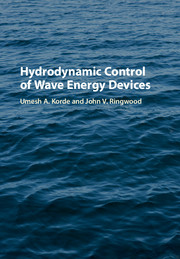Book contents
- Frontmatter
- Contents
- Preface
- Acknowledgments
- Part I Introduction
- Part II The Basics
- Part III The Hydrodynamics
- Part IV Velocity Control Using a Hydrodynamic Model
- Part V Control by Optimizing a Performance Index
- Part VI Toward Overall WEC System Hydrodynamic Optimization
- 13 Position and Force Constraint Analysis and Optimization
- 14 Interaction between Control and Optimum System Design
- Part VII In Closing
- References
- Index
14 - Interaction between Control and Optimum System Design
from Part VI - Toward Overall WEC System Hydrodynamic Optimization
Published online by Cambridge University Press: 05 September 2016
- Frontmatter
- Contents
- Preface
- Acknowledgments
- Part I Introduction
- Part II The Basics
- Part III The Hydrodynamics
- Part IV Velocity Control Using a Hydrodynamic Model
- Part V Control by Optimizing a Performance Index
- Part VI Toward Overall WEC System Hydrodynamic Optimization
- 13 Position and Force Constraint Analysis and Optimization
- 14 Interaction between Control and Optimum System Design
- Part VII In Closing
- References
- Index
Summary
Introduction
Throughout the application history of control systems, a disconnection between the tasks of physical system design and control design is often apparent. Typically, the application specialist designs the physical system, based on years of application experience, and the system is then given to the control engineer for the subsequent design of a suitable control system to optimize the operation of the device, as illustrated in Fig. 14.1(a).
However, it is unlikely that an optimal controlled system results from this sequential approach, since the geometric/structural design is fixed on entry to the control design stage. A better result can usually be obtained if the application specialist is aware of the potential and requirements of the control system, so that the control system may be taken into account at the geometric/structural design stage, as suggested in Fig. 14.1(b). Unfortunately, for a variety of reasons, often related to a lack of communication or trust between the application-specific and control domains, the sequential route is the normal one. There are a few notable exceptions, usually in relatively exotic application areas such as aerospace, where large multidisciplinary teams design such systems and there is always a quest for higher performance. For example, the General Dynamics F16 Fighting Falcon was the first aircraft to feature relaxed static stability in the knowledge that a feedback control system would stabilize the system, resulting in superior aerodynamic performance than an aircraft with inherent positive static stability across the full operational envelope [247].
This chapter examines two scenarios where cooperative design between the designers of wave energy systems and control engineers can result in performance in excess of what can be achieved using the sequential design philosophy of Fig. 14.1(a). In Section 14.2 the interplay between the control system and the optimal (single) device geometry is examined, while Section 14.3 considers the interaction between the control system and the optimal layout of wave energy converters (WECs) in wave farms.
Sensitivity of Optimal Wave Energy Device Geometry to Control
In general, the WEC geometry is designed for the prevailing sea conditions in a particular location, with control subsequently used to improve the energy conversion performance of the device for sea states other than the design sea state. This usually involves matching the device frequency response, or response amplitude operator (RAO), to the predominant sea spectrum.
- Type
- Chapter
- Information
- Hydrodynamic Control of Wave Energy Devices , pp. 316 - 344Publisher: Cambridge University PressPrint publication year: 2016



